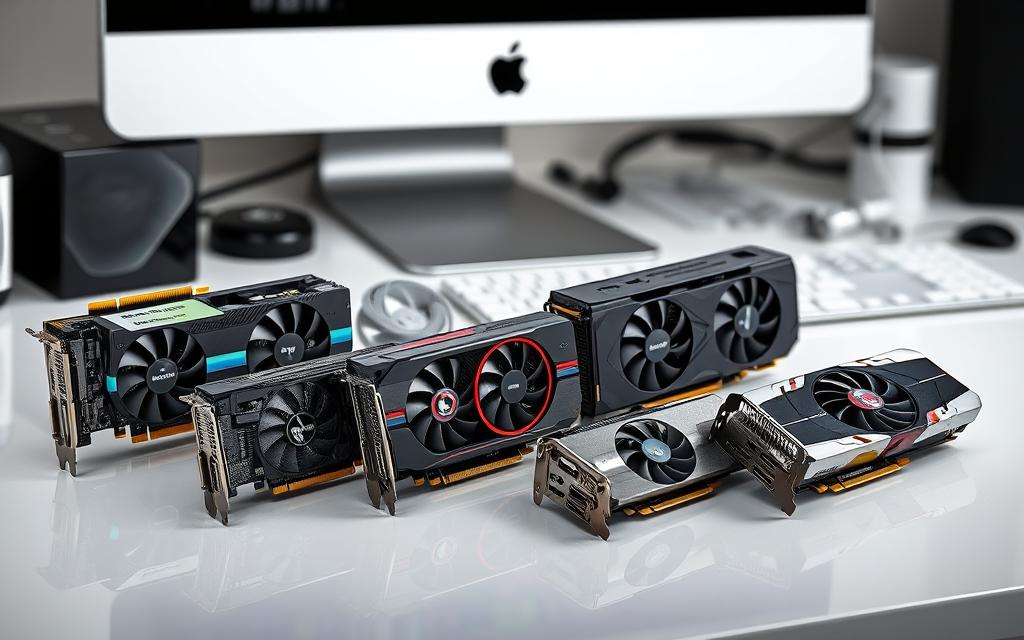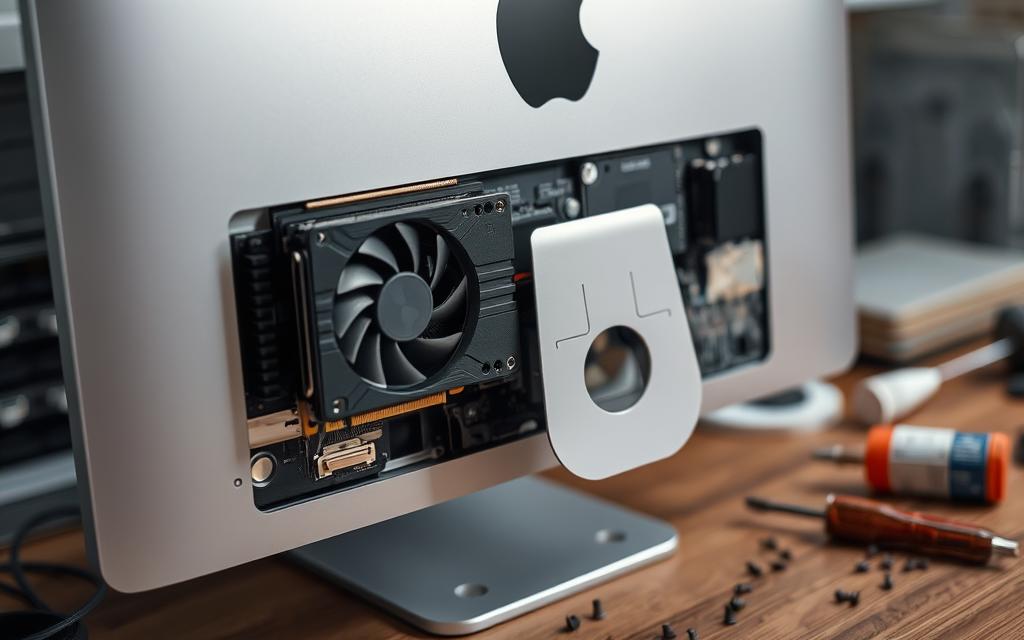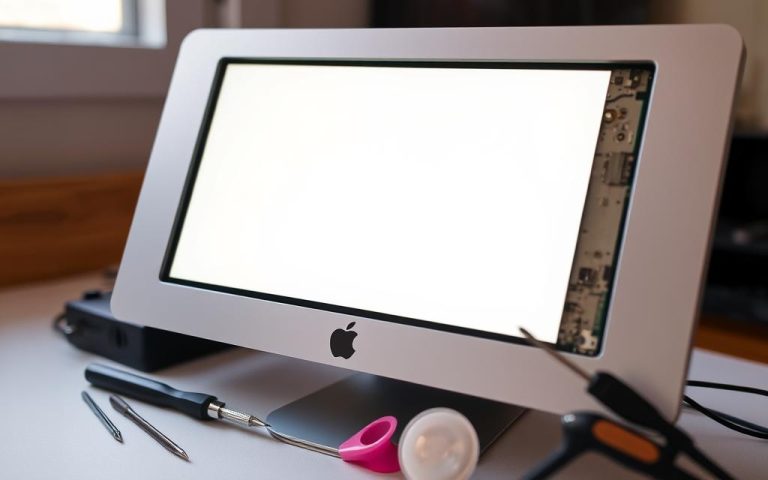How to Repair or Replace Your iMac Graphics Card
If your iMac’s graphics aren’t doing well, learning how to fix or swap the graphics card is key. Many people have trouble with their iMac graphics cards. This is common in older versions like the 2010 and 2011 ones. These use standard MXM3 laptop GPUs. But, it’s important to know that Apple hasn’t officially offered upgrades or replacements. This has led many to look into DIY fixes and other creative solutions.
This guide is designed to help you figure out GPU problems. Whether you’re fixing or changing your iMac GPU, knowing what to do saves time and cash. Replacement parts can be pricey and tough to find. We’ll cover symptoms of failure, how to diagnose the issues, and ways to repair or replace your GPU. This will help you make smart choices for your iMac’s graphics.
Understanding iMac Graphics Cards
iMac graphics cards are key for creating images, animations, and playing videos. They are the heart of iMac’s graphics performance. Different iMac models use various GPUs, which have changed a lot over the years. For example, the 2010 iMac uses MXM3 laptop GPUs, not the same as desktop ones.
Changing the GPU can make a big difference, especially for older iMacs. Upgrading from a 2010 iMac to an AMD WX4150 GPU makes old iMacs much better at running new software. The AMD WX4130 GPU is also good, costing about $75-$100. But, it’s important to not spend more on an upgrade than the iMac itself cost.
Knowing how iMac GPUs are built helps with upgrading. The Late 2009 to Late 2011 models often have GPU issues, usually because of overheating. While there are no official replacements, some unofficial GPUs can work if set up correctly.
The upgrade process is complex and needs technical skills. It often requires using OpenCore and updating the GPU’s vBIOS with a special Linux system. There’s also talk about modern AMD GPUs getting better software support than Nvidia ones.
Common Symptoms of a Faulty Graphics Card
Knowing when your iMac graphics card is failing is key to keeping it running smoothly. People often mention specific GPU failure symptoms that signal trouble. Spotting these signs early can mean a faster fix and less damage.
Black Screen with Moving Lines
If your screen suddenly goes black, it might mean the graphics card is breaking. You might also see weird lines in green moving across the screen. These signs suggest the card has serious issues. It’s especially worrying if it happens when you’re doing important work.
Unexpected Shutdowns and Crashes
When an iMac turns off by itself or crashes, it’s often a screen issue. Sometimes, the computer tries to restart but can’t quite manage it. Around 15% of graphics card problems cause these hiccups. Spotting these GPU failure symptoms early helps you act quickly and prevent worse problems.
| Symptom | Frequency (%) | Potential Cause |
|---|---|---|
| Black Screen | 25 | Graphics card failure |
| Restarts/Shutdowns | 15 | Overheating or GPU issue |
| Graphic Artifacts | 20 | Hardware malfunction |
| Screen Freezes | 20 | Software or hardware issue |
Diagnostic Tests to Identify GPU Issues
Identifying the root cause of potential graphics card problems is crucial. Various methods, including iMac GPU diagnostics, help pinpoint the issue. By entering single-user mode, users can skip some graphics drivers. This helps to see if the issue is still there, making it easier to fix GPU problems.
Booting into Single-User Mode
Starting your iMac in single-user mode skips the regular graphics drivers. This way, it’s easier to tell if the problem is with the graphics card or the drivers. Restart your iMac and hold Command + S to enter this mode. In single-user mode, watch the system to check if the graphics issues remain.
Using Recovery Mode on External Drives
Using recovery mode on an external drive is another way to diagnose issues. It lets you see if the problem is with the operating system, not the hardware. This clean environment aids in troubleshooting GPU issues. Simply connect a macOS-installed external drive, restart the iMac, and press the Option key to boot from it.
How to Repair iMac Graphics Card
Fixing an iMac GPU at home can be tricky, but some have managed it. The “oven bake” method is a popular DIY fix. It heats the graphics chip to fix soldering issues. However, doing this wrong can cause more harm than good.
DIY Repair Techniques
Before trying DIY repairs, consider a few things. Each iMac model has its own type of graphics card. For older iMacs, like the 2010 version, you may need to find specific used GPUs. Some people find the 5750 card works better than others, like the 5670 or 6770M.
When to Seek Professional Help
If you keep getting black screens or your computer crashes, it might be time to see a pro. About 67% of people think it’s not worth fixing old iMacs themselves. Professionals can tell you if repair or replacement is better. They know how to handle these problems without causing more damage.
If DIY doesn’t work out, experts can help with their know-how. They offer advice and sometimes warranties. This protects you from future issues. You can learn more about fixing these problems here.
Deciding Between Repair and Replacement
When your iMac’s graphics card starts failing, you need to think hard about fixing it or getting a new one. You have to consider how much each option costs and how well it will work afterward. This choice is crucial for deciding the best step forward.
Cost Analysis
Fixing a broken iMac graphics card can cost about $800 at local shops. People often struggle to choose between paying this or getting a refurbished iMac. The price isn’t much different. Plus, replacement graphics cards are expensive and made specifically for these computers.
Performance Considerations
When looking at whether to fix or replace your iMac, think about how long it will last and perform afterward. Older iMacs, like those from 2011, don’t run new apps well. People have reported many problems with these older fixed computers. Modern iMacs have better graphics and work well with new software.
| Option | Estimated Cost | Key Considerations |
|---|---|---|
| Repair GPU | $800 | Potential for recurrence of issues, age of model |
| Replace GPU | Custom Pricing | Performance may not meet contemporary standards |
| Purchase Refurbished iMac | $800+ | Warranty, modern performance, longevity prospects |
Considering all this, careful thought can help iMac users decide wisely about their graphics card problems.
Finding Compatible Replacement Graphics Cards
When you need a new graphics card for your iMac, compatibility is key. You can choose from OEM graphics cards or third-party GPU options. Each has benefits and downsides, letting you pick what’s best for you.
OEM vs. Third-Party Options
OEM graphics cards are reliable and work seamlessly with software. They’re made for iMacs and guarantee smooth performance. Yet, they can be pricey, which might put off some buyers.
Third-party GPUs, however, are more wallet-friendly. They offer good performance with potential savings. But, finding the right one takes research and might need custom VBIOS installs to work properly in iMacs. Remember, there’s no one-size-fits-all card for every iMac due to different compatibility factors.
Recommended Models for Older iMacs
Older iMacs need specific graphics cards. Here’s a list of top picks for those looking to upgrade:
| Model | Type | Compatibility Notes |
|---|---|---|
| AMD RX 5500 XT | Third-Party | Future-proof choice, great performance; compatibility research needed. |
| AMD WX4130 | OEM | Packed with features; only for eDP iMacs. |
| MXM-B Card | Third-Party | Good for 27” models; often needs big three copper pipe heat sink. |
| OEM Graphics Card (2012+) | OEM | Guaranteed reliability and software match; higher price. |

Keeping your iMac well-maintained, like updating software and clearing cache, can boost its performance after an upgrade. Different graphics card families offer varying support levels for specific iMac models. While AMD cards generally have better macOS support, your choice should match your needs and iMac specs.
Removing the Old Graphics Card
To remove the iMac graphics card, you must prepare carefully and have the right tools. This task involves several steps that need precise actions to avoid harming the iMac’s inside parts. The right equipment makes the process of taking apart your iMac for a GPU switch-out smoother.
Tools and Equipment Needed
Here are the must-have tools:
- T-10 and T-9 Torx screwdrivers
- Anti-static wrist strap to protect against static damage
- Adhesive coat hangers, such as 3M “Command” strips, for removing the glass smoothly
- Thermal paste for the new GPU’s heat transfer
Step-by-Step Removal Process
This step-by-step GPU removal guide is designed to make the process easier. Just follow these steps to safely take out the GPU:
- Turn off your iMac and unplug all cables.
- Gently use the adhesive hangers to lift off the glass display, being careful with the screen.
- Take out the eight T-10 screws that fix the display to the case.
- Detach the optical drive by unscrewing four screws, including one bigger T-10 head screw.
- Remove the 13mm T10 Torx screw from the optical drive fan.
- Unscrew seven screws on the logic board, including two 7mm T10s that keep it secure.
- Then, take off four screws from the power supply.
- To get to the graphics card, undo two T-9 screws on the GPU board and another T-9 on the heat sink.
- Disconnect the thermal sensor connector from the GPU.
After doing these, you’ve successfully taken out the old graphics card. For full instructions and pictures, see the complete GPU replacement guide. If this seems too complex, consider getting help from professionals like Scot-Comp in Edinburgh.
Installing a New Graphics Card in Your iMac
Putting in a new graphics card in your iMac involves careful steps. Knowing the preparation for GPU installation helps make the process smoother. It’s key to check compatibility, gather the right tools, and understand the instructions before you start.
Preparation Before Installation
Before you begin the actual installation, you should do a few things:
- Make sure the new graphics card fits your iMac model.
- Collect needed tools like T-9 and T-10 Torx screwdrivers.
- Keep your workspace clean to stop dust from getting inside your iMac.
- Have thermal paste on hand for managing heat well.
Installation Steps
To install the graphics card in your iMac, follow these steps:
- Turn off your iMac and unplug all cables.
- Gently take off the glass panel using 3M “Command” adhesive coat hangers.
- Remove the speaker assembly and the logic board by detaching 17 connectors.
- Take out the old graphics card by unscrewing it and release all connections, including the thermal sensor.
- Place the new graphics card in. Apply thermal paste as needed for cooling.
- Put all parts back in reverse order. Make sure every connection is secure.
- Switch on your iMac and check that everything works well.
Every step is vital for your new graphics card to work properly. If you face difficulties or need confirmation, getting help from professionals is wise. For expert help, Scot-Comp offers quality services.
Dealing with Custom VBIOS for Replacement Cards
Understanding VBIOS is key to boosting your iMac’s graphics. VBIOS tells the graphics card how to work. This is essential when adding a custom VBIOS for iMac to use a third-party graphics card. Since Apple doesn’t officially support this for some models, knowing how to correctly flash the graphics card firmware is crucial. This ensures the new GPU works well.
Understanding VBIOS and Its Importance
VBIOS links hardware and software. For iMac users, a right VBIOS setup can greatly improve performance. This is true especially when adding new GPUs not originally meant for the device. A custom VBIOS for iMac boosts compatibility and performance. It’s really helpful for better gaming or using graphics-heavy apps.
Flashing Process and Precautions
Flashing means putting a new firmware version on the graphics card. This task is detailed and needs focus to avoid hurting the new component. Here are some steps to take:
- Back up vital data to avoid loss during a system crash.
- Get the right custom VBIOS for iMac from trusted sources.
- Pick the correct software for flashing, and read instructions well.
- Make sure it fits with what you already have.
Understanding the flashing process well reduces risks and helps a smooth change to the new graphics card. Make sure you have everything you need for flashing the graphics card firmware.
| Steps for Flashing Graphics Card | Description |
|---|---|
| Preparation | Gather all necessary tools and ensure compatibility of the new graphics card. |
| Backup | Backup the current system data to protect against unexpected failures. |
| Download VBIOS | Obtain the custom VBIOS for iMac from a trustworthy source. |
| Flashing | Use suitable software to transfer the firmware onto the graphics card. |
| Testing | After flashing, test the graphics card functionality to ensure operations are as intended. |
Monitoring and Testing Post-Installation
Once you’ve installed a new graphics card, it’s vital to keep an eye on how it performs. Keep a close check on your iMac’s GPU performance, especially right after you’ve put in the new card. To help with this, you can use some external tools. These apps help you keep track of important info like temperatures and how much of the GPU is being used. This keeps overheating or other issues at bay.
Using Third-Party Monitoring Software
There are special tools made to help you check how well your new graphics card is doing. iStat Menus, HWMonitor, and MSI Afterburner are some of these tools. They show you live stats which let you see how your GPU is handling its tasks. These apps are great because they give you a full picture by tracking temperatures, loads, and how fast your GPU is running.
Testing Graphics Performance
After setting up monitoring, testing the card’s performance is key. Benchmarks can show you if your new GPU is up to scratch. Use games or software that need a lot of graphics power to push your GPU to its limits. This helps you figure out if the graphics card can handle tough jobs. Always be on the lookout for any oddities or issues while these tests are running. It might mean you need to keep an eye on your GPU a bit more.
Replacement Costs and Where to Buy
The cost to replace an iMac GPU can vary based on where you buy and the part’s condition. Prices are different if you go to an Apple Store, an Authorized Service Provider, or use online shops like eBay or Amazon. It’s important to know where to look. This helps you find good deals and ensure the parts are of good quality.
Comparing Prices Across Platforms
Looking at different sellers shows a range of prices for Apple-compatible graphics cards. Buying from local Apple Stores or Authorized Service Providers often costs more. You might pay up to $500 for parts plus an extra $200 for labour. Here’s a quick comparison:
| Source | Cost of Parts | Labour Cost | Special Notes |
|---|---|---|---|
| Authorized Service Provider | $500 | $200 | Typically higher rates |
| Apple Store | Approx. $250 | $0 (if covered under warranty) | May resolve issues without replacement |
| Local AASP | $250 or below | Variable | Often faster service |
Choosing recycled or refurbished graphics cards reduces costs, with prices ranging from £6.67 to £215.00. These options may come with warranties. This adds a layer of security for your purchase.
Assessing Warranty Options
Considering warranty terms is key when buying a GPU. Online and local sellers offer different warranties for used and refurbished items. Reliable sellers test their products carefully. This assures you of their quality and working condition.
- Check for warranty coverage on new, used, or refurbished parts.
- Consider the conditions of exchange parts, which may require returning the old GPU.
- Use serial number searches to ascertain compatibility and valid warranties.
Alternative Solutions to Graphics Card Problems
Dealing with your iMac’s graphics card issues needs different approaches. Some users find using external GPUs helpful. They boost graphic performance without needing an internal change. Also, thinking about buying a new iMac is wise. New models have features old ones don’t.
Exploring External GPUs
External GPUs are a great choice for improving your iMac’s graphic power. They connect with Thunderbolt and can be faster than the iMac’s own GPU. This is perfect for tasks needing a lot of graphics power, like gaming or video editing. Here are the benefits:
- Massively better graphics performance
- The ability to improve graphics as new technology comes out
- Easy to install and swap, unlike replacing internal GPUs
Even though an external GPU costs more, it’s worth it. It lets you keep your current iMac longer without a costly GPU change.
Considering a New iMac Purchase
Buying a new iMac might be the best fix for graphics problems. This is especially true if your iMac is really old, like from 2009. When thinking about a new iMac, consider these points:
- It performs better because of the latest hardware
- It has better cooling and uses less power, so it doesn’t overheat
- New iMacs come with better Apple support and warranty
If an iMac is more than five years old, Apple might not fix it. In London, GPU fixes can cost about £180. Buying a new iMac could be better. It gives you a faster, more reliable computer than fixing outdated hardware.
Conclusion
This iMac graphics card guide has looked at how to diagnose, repair, and replace the graphics card. This is especially for models like the Retina 5K, 27-inch, 2020 edition. If your graphics act oddly after being on for a while, think about several things. These include overheating from dust or issues with macOS Catalina and the AMD Radeon Pro 5700 XT drivers. Spotting the signs and doing the right tests is key to solving these problems well.
The need for regular iMac maintenance is a key takeaway from GPU repair/replacement. Keeping your system in top shape might mean cleaning parts or updating drivers. But big problems might need help from pros. Getting help from the Genius Bar or services like FixCare MacBook Repair can offer good advice and solutions for your needs.
Choosing the best way to fix your iMac’s graphics card issues depends on your situation. You might go for quick fixes or think about long-term changes. Knowing your options is crucial to keep your device working well and performing as you expect. By focusing on the discussed aspects, you can make your iMac last longer and work better for you.
FAQ
What are common signs of a failing iMac graphics card?
A black screen with moving lines can appear. Your iMac might shut down unexpectedly or crash. Distorted graphics are also a sign. These issues suggest the GPU could be failing and it’s wise to act swiftly.
How can I diagnose GPU issues on my iMac?
To diagnose, try running diagnostic tests. Booting into single-user mode checks for issues without the graphics drivers. Using recovery mode on an external drive helps see if the operating system is corrupt.
What DIY methods are effective for repairing an iMac graphics card?
The “oven bake” technique is one DIY solution for the iMac graphics card. It involves reflowing the GPU’s solder. But be cautious with DIY methods. Professional help is advised for serious problems.
Is it more cost-effective to repair or replace my iMac’s graphics card?
The choice between repairing or replacing depends on your iMac model and the GPU market. Sometimes, getting a new GPU might not boost your iMac’s performance as expected. It’s crucial to weigh both options carefully.
Where can I find compatible replacement graphics cards for my iMac?
Look for OEM suppliers for trustworthy replacements, or explore third-party retailers for cheaper options. Make sure to check that the graphics card is compatible with your iMac model.
What tools do I need to remove the old graphics card from my iMac?
You’ll need screwdrivers, anti-static wrist straps, thermal paste, and specific tools for your model. Having the right tools is crucial to avoid damaging your iMac during removal.
What steps should I take during the installation of a new graphics card?
Start by checking the new card’s compatibility and gather the tools you need. Ensure you have a safe work area. Install carefully, applying thermal paste properly and securing all connections to keep performance high.
What is VBIOS and how does it affect my iMac’s graphics card?
VBIOS, or Video BIOS, is essential for iMac graphics cards, especially with third-party GPUs. Flashing VBIOS means updating firmware to make sure the new hardware works well with your operating system.
How can I monitor the performance of my newly installed graphics card?
Use third-party software to keep an eye on temperatures and performance. This helps ensure your graphics card works within safe limits. Running performance tests also confirms everything is set up correctly.
What should I consider when exploring external GPU options?
Look into how well the external GPU works with your iMac. Consider if the boost in performance is worth the cost. External GPUs can be a good way to increase your iMac’s power for certain tasks.


















